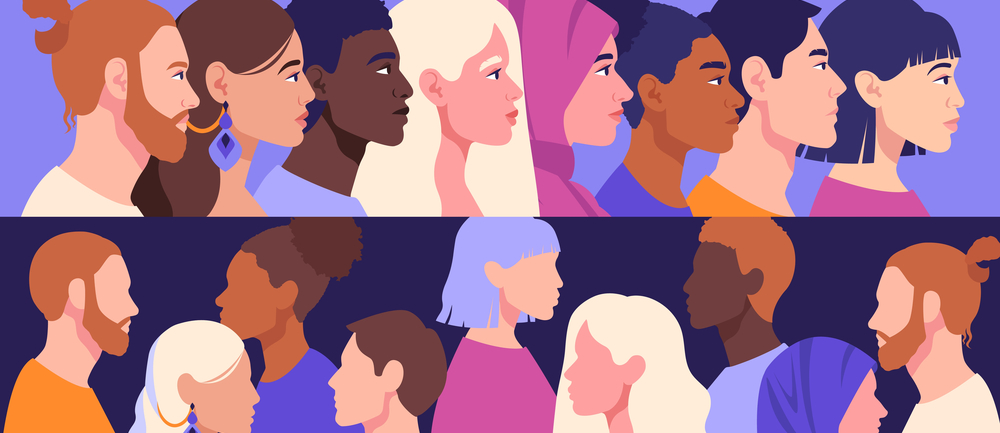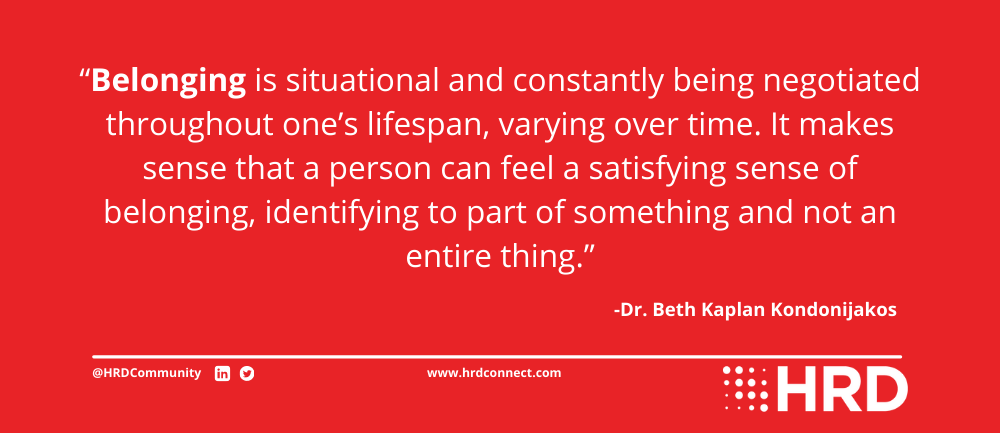Distinguishing diversity, inclusion, and belonging in the workplace
- 7 Min Read
Dr. Beth Kaplan outlines why it’s critical for businesses to distinguish between diversity, inclusion, and belonging, offering a call to action for HR leaders to bring meaning to the employee experience to each in their own right.
- Author: Beth Kaplan
- Date published: May 9, 2022
- Categories

In the last 10 years, a common trend is that companies have expanded their executive boards to include titles with the words equality and diversity to ensure a more equitable workplace. Typically, companies throw everything and the kitchen sink under that umbrella–all for a noble, worthy goal: to increase belonging throughout their workforce. The lengths companies are going to increase belonging can feel like killing a fly with a hammer. And why? The world around us has changed (understatement of the last 3 years), and employee retention has done more flips than an Olympic gymnast. Fortune estimated that US companies spend $8 billion a year on diversity, equity, and inclusion (DEI) to produce an outcome of belonging, which helps their bottom line. Is it working?
That’s a tricky question to answer. We know that people are leaving companies at an alarming rate. For example, in the US alone, the Bureau of Labor Statistics reports that unemployment in March 2022 hit 3.6% for many many reasons. Companies have delivered lackluster results on increasing diversity beyond awareness, pairing belongingness with tangible results. As such, I will make a case for why diversity, inclusion, and belonging initiatives should be separate in the workplace and include actions that HR leaders can take to improve each in their own right.
Distinguishing diversity, inclusion, and belonging
While diversity, inclusion, and belonging have different meanings, they are often grouped in an effort to encourage fairness in today’s workplace. Diversity goes beyond the measurement of demographics as these differences impact acceptance and progress in an organization. In an inclusive workplace, employees feel that they are treated fairly, appreciated, accepted, and invited to contribute to the company’s success. They feel safe and are comfortable expressing their thoughts in an environment where diversity of thought is valued.
Diverse representation and diversity of thought do not automatically form an inclusive workplace nor one where everyone feels like they belong. High-performing companies realize that to achieve diversity and inclusion, they need to embrace and accommodate different thinking styles.

Inclusion in the workplace emphasizes encouraging participation and employee involvement. It’s finding ways to move beyond merely appreciating diversity towards leveraging and integrating diversity into everyday work life. While diversity is an important aspect that informs inclusion and a sense of belongingness, they are not the same. t’s time for HR to take the lead on encouraging diversity of thought and making policy changes, implementing a culture of psychological safety, to improve employee inclusion and sense of belonging.
A culture of inclusion
A culture of inclusion in the workplace allows people with multiple backgrounds, mindsets, and ways of thinking to perform to their highest potential and work effectively together.
Of the terms used most interchangeably, inclusion and belonging in the workplace are most easily confused because they symbolize connection and acceptance, but cognitively they are very different. They’ve become synonymous with one another, yet while others determine inclusion, belonging is negotiated at the individual level, based on interpersonal motives influencing behavior, emotions, and thoughts. In the workplace, inclusion is a behavior, and belonging is the outcome that people want to feel part of something bigger than themselves, the community, or the organization.
Exclusion hurts, and we know that ill effects are related to how people feel included and accepted by others, significantly influencing their sense of belonging. These ill effects related to inclusion, stress, and doubts are essential in understanding the psychological considerations, confusion, and ambiguity that a person goes through when assessing their sense of belonging in the workplace. This gives credence to the precariousness that individuals experience when trying to assess who they are and if they belong when trying to make sense of their belonging.
One of the goals of the diversity and inclusion training is to help employees recognize that certain biases exist, how it motivates us, and how we can take steps to reduce the impact of exclusive practices around interactions and decisions made at work. Positive and negative biases are an integral part of self and social identity.
The case for focusing separately on belonging
Institutions and social groups can set the rules for belonging, doing so in a way that functionally precludes individuals from membership resulting in exclusion. In addition, institutions and social groups establish methods and measurements for identifying belongingness, which is only effective if the instrument measures what it seeks to measure. However, belonging is an individual’s choice, and it’s not an all-or-nothing decision: employees may experience partial belonging in the workplace.
Belonging is situational and constantly being negotiated throughout one’s lifespan, varying over time. It makes sense that a person can feel a satisfying sense of belonging, identifying to part of something and not an entire thing. For example, in the workplace, employees may feel belonging to the company but not to the team, their manager, or even the people that make up the organization. Or, they may feel part of the team, manager, or job but not connect to the company culture, values, or vision.
One example of partial belonging has been evidenced through Employee Resource Groups (ERGs). ERGs are volunteer-based workplace groups composed of individuals who share a common demographic, life stage, function, or alternative identity. ERGs not only vary by company and within each company, but groups can also be very different due to the nature of employees with diverse backgrounds, different ideas of what success looks like, and how their charters align with the company’s mission. Research tells us that employees are attracted to ERGs to be socially connected with people of like background and demographics. However, they report that when they are with the ERG, they have a false feeling that diversity issues have been solved across the company due to a strong sense of belonging, or they may experience a heightened awareness of the diversity missing across the company. In both cases, members experienced a disconnect with the company, leading to a sense of belonging to the group, but not the company.
When asked if their partial sense of belonging to the ERG was enough to keep employees at the company, members said it was not enough to keep them there. ERGs are just one example of partial belonging that HR leaders should think about when breaking down belonging complexity in their organizations since it’s not all or nothing.
HR’s call to action
Given this landscape, here are some calls to action that HR can take to distinguish diversity, inclusion, and belonging while bringing value and meaning to each employee in their own right:
- On Diversity: HR should take the lead on encouraging diversity of thought and making policy changes around diverse representation. One place to start is with recruiting practices. Make sure to include competencies like debate-making or radical candor, and promote diversity of thought. It is the role of HR to cultivate diverse leaders and all employees throughout the company, starting with rounding out your talent pool.
- On Inclusion: In addition to unconscious bias training, HR leaders should think about giving training geared at combating known biases, attitudes, and beliefs, particularly when they concern stereotypes and prejudices, and how to overcome them for the sake of a more inclusive, positive workplace. Psychological safety training may also be used to address this issue.
- On Belonging: HR can decouple belonging from equality programs and initiatives. One place to start would be to examine all of the different entry points of belonging: company, team, manager to subordinate, individual, partial, etc. Building a belonging strategy can start here.
Dr. Beth Kaplan Kondonijakos is a researcher and storyteller with expertise in belonging, belonging in the workplace, and workplace trauma. You can reach her by her LinkedIn









